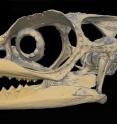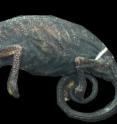Single no more: First females of a Madagascan chameleon described with modern technologies
The first females of a scarcely known chameleon species from Northeast Madagascar have been described. Because of lack of genetic data, X-ray micro-computed tomography scans of the chameleon's head were used for species assignment. Regrettably, the habitats of this and many other chameleon species are highly threatened by the ongoing deforestation in Madagascar. The study is published in the open-access journal Zoosystematics and Evolution. Chameleons belong to the most popular animals of Madagascar and have been quite intensively studied in the past. However, many new species are still being discovered and described, and several species are only known by a single or a few specimens. Likewise, the chameleon species Calumma vatosoa from northeastern Madagascar was described in 2001 based on a single male. The identity of females of this species has been unclear until now.
Recently, the PhD student David Proetzel of the herpetology section of the Zoologische Staatssammlung Munchen (ZSM), Germany, found specimens of female chameleons in the collection of the Senckenberg Museum, Frankfurt am Main, Germany, that looked similar to Calumma vatosoa. The problem was, how to prove this? The specimens from Frankfurt were collected back in 1933 and therefore, the extraction of DNA for genetic analysis was not possible anymore.
Researchers of the ZSM have been using X-ray micro-computed tomography scans for a few years to study the internal morphology of organisms in a non-invasive way.
"With the help of Micro-CT you can investigate even the skeleton of very valuable samples like holotypes without destroying them," explains David Proetzel.
"In chameleons the morphology of the skeleton, especially the skull, contains important characteristics that distinguish different species," explains the researcher. "Here, the comparison of the skulls of the male and the female showed that they belong to the same chameleon species. With the help of modern technology we could describe females of Calumma vatosoa for the first time, and add another distribution locality of this species."
"The habitats of many chameleon species, and not only, are highly threatened by the ongoing deforestation in Madagascar and we need rapidly to expand our knowledge about the biodiversity, so that suitable conservation measures can be taken," he stresses.
Source: Pensoft Publishers
Articles on the same topic
- Welcome to the world: New chameleon emerges from wilds of TanzaniaWed, 27 Jan 2016, 17:07:05 UTC
Other sources
- Welcome to the world: New chameleon emerges from wilds of Tanzaniafrom Science DailyWed, 27 Jan 2016, 17:57:40 UTC
- Single no more: First females of a Madagascan chameleon described with modern technologiesfrom PhysorgWed, 27 Jan 2016, 16:52:44 UTC
- Welcome to the world: New chameleon emerges from wilds of Tanzaniafrom PhysorgWed, 27 Jan 2016, 16:51:53 UTC
- Welcome to the World: New Chameleon Emerges From Wilds of Tanzaniafrom Newswise - ScinewsWed, 27 Jan 2016, 16:26:27 UTC

